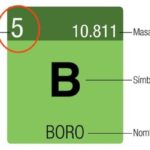We explain what Avogadro's number is, what the value of this constant is and a brief history of its invention.

What is Avogadro's number?
In chemistry, Avogadro's number or Avogadro's constant is called number of constituent particles of a substance (usually atoms or molecules) that can be found in the amount of one mole of the substance. It is a proportion factor that relates the molar mass (physical quantity that defines the mass of a substance per unit amount of substance and is expressed in kg/mol) of a substance and the mass present in a sample.
The accepted value of this constant is 6.02214087(62) x 1023 mole-1.
Currently the term Avogadro's constant is used instead of “Avogadro's number”. The difference between both terms is that Avogadro's constant contains units of measurement and Avogadro's number is dimensionless.
Jean Baptiste Perrin initially defined Avogadro's number as the number of atoms in one mole of hydrogen (H). This value was then redefined as the number of atoms in 12 grams of the carbon-12 isotope and later, it was generalized to relate molar masses to quantities of substances.
An example that helps understand this is: In 1 gram of hydrogen there is approximately 6.022 x 1023 hydrogen atoms while in 12 grams of carbon-12 there are exactly the same number of atoms. Both one gram of hydrogen and 12 grams of carbon-12 have 6.022 x 1023 atoms, even though the atomic mass of hydrogen is 1 amu (atomic mass unit) and that of carbon-12 is 12 amu.
This is fundamental for the experimental knowledge of chemistry. For example, to generate 1 mole of water (H2O) 1 mole of oxygen (6.022 x 10) combines23 atoms) with 2 moles of hydrogen (2 x 6.022 x 1023 atoms). This, of course, in accordance with the measurements accepted by the International System (SI).
See also: Valencia
History of Avogadro's Number
The discovery of this constant is attributed to Amadeo Avogadro an Italian scientist from the early 19th century who first proposed in 1811 that a volume of a gas at a given pressure and temperature contains the same number of atoms or molecules, regardless of the nature of the gas itself.
Avogadro's Number was, however, postulated in 1909 with that name, by the French physicist Jean Perrin, who won the Nobel Prize in Physics in 1926, largely thanks to his efforts to determine the exact value of Avogadro's Constant using various experimental techniques and methods.
References
- “Avogadro's constant” in Wikipedia.
- Mohr, Peter J.; Taylor, Barry N.; Newell, David B. (2008). CODATA Recommended Values of the Fundamental Physical Constants: 2006. Reviews of Modern Physics 80: 633-730. doi:10.1103/RevModPhys.80.633. Direct link.





